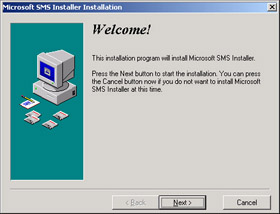| < Day Day Up > |
SMS Installer is available for download from the SMS Web site (http:// www.microsoft.com/smserver). To use SMS Installer, you must first download the self-extracting executable file Smsimain.exe and then run it on an SMS 2003 primary site server. The executable file checks to see whether the server is a primary site server. If the server isn’t a primary site server, the installation stops. If the server is a primary site server, the SMS Installer files are copied to a directory you specify or by default to %SystemDrive%:\SMS Installer Setup. SMS Installer itself consists of a single self-extracting file, Smsinstl.exe, that you can copy and run on a reference computer. We’ll talk about reference computers in detail later in this chapter. Smsinstl.exe includes all the SMS Installer support files needed to set up the utility on a reference computer.
The next phase is to configure a reference computer. SMS Installer supports any computer running Windows 95 and higher and requires about 5 MB of RAM and at least 6 to 11 MB of hard disk space for the installation. The reference computer must be a standard desktop configuration that’s representative of your target computers. This computer contains the applications and registry settings that are configured on the end-user systems. It’s critical that the reference computer be identical to the computer systems on which you’ll be installing the final software package. Be sure to check the following system components:
Hardware devices The devices installed on the reference computer should match those installed on prospective target clients, including graphics cards, modems, I/O configurations, and disk drive configurations, especially if the application references these components during its installation.
Operating system The reference computer’s operating system should match that of all target systems, including version number and perhaps even service packs installed, especially if the application is platform specific.
Installed applications The reference computer and all target computers should have the same applications installed. Unless the repackaged application has a specific dependency on an existing application, the reference computer should contain only software that the repackaging process directly needs.
Directory structure If your script includes telling the application where to place the application’s installation files, it’s imperative that the reference computer’s directory structure and the directory structures of the prospective target clients be standardized. Any changes, however insignificant they might be in the mind of the user—for example, moving or renaming the Program Files directory—can result in failure to run the script.
As you can see, the choice and configuration of the reference computer is one of the keys to creating a successful script using SMS Installer.
Once you’ve selected and properly configured the reference computer, you can install SMS Installer. Remember, the more closely the reference computer resembles the proposed target computers, the higher the rate of success for using SMS Installer.
To install SMS Installer, follow these steps:
Copy the Smsinstl.exe self-extracting executable file to the reference computer.
Run Smsinstl.exe to start the Microsoft SMS Installer Installation Wizard. Read the license agreement that displays and click Agree to display the Microsoft SMS Installer Installation Welcome page, shown in Figure 14.1.

Figure
14.1: The Microsoft SMS Installer Wizard Welcome
page.
Click Next to display the Select Destination Directory page, shown in Figure 14.2. Specify the destination directory for the SMS Installer files. By default, they will be placed in a folder named Microsoft SMS Installer under the Program Files directory.
Click Next to display the Backup Replaced Files? page, shown in Figure 14.3. From this page you specify whether to create a backup of all files replaced during the installation. Select Yes to keep a copy of the files that are changed during the SMS Installer installation. Select No to overwrite these files.
Click Next to display the Select Backup Directory page, shown in Figure 14.4, and select a location for the backup files to be written to. (This page won’t appear if you selected No in the previous page.) By default, the backup files will be written to a folder named \Backup in the installation folder you defined in step 3.
Click Next to display the Ready To Install page, shown in Figure 14.5.
Click Next to copy the files and then display the Installation Completed page, shown in Figure 14.6. Click Finish to exit the SMS Installer installation process.
Once the installation of SMS Installer is complete, the utility is ready for use. When SMS Installer is installed, it creates its own program group on the Start menu. You can access the utility by choosing Programs from the Start menu and then selecting the Microsoft SMS Installer program group. Alternatively, you can navigate directly to the Program Files\Microsoft SMS Installer directory through Windows Explorer. With either method, you’ll be able to select the appropriate development environment by selecting the appropriate program entry in the SMS Installer program group or by double-clicking Smsins32.exe.
| < Day Day Up > |